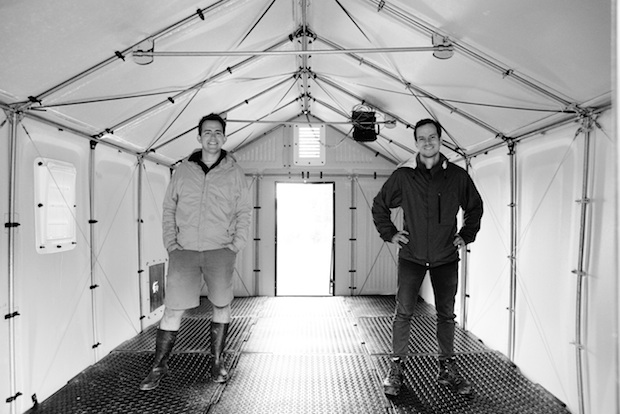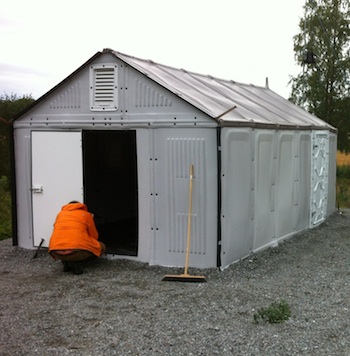
Scott Key, left, and Sam Brisendine stand inside a test shelter that rests on their Emergency Floor. The project has been flagged for funding by the government's USAID program.
Rice School of Architecture alums win federal funding for Emergency Floor project
A project born at the Rice School of Architecture is about to enter the wider world in a big way.
The Emergency Floor project initiated by Rice Building Workshop students has been flagged for funding by the federal government’s USAID program, which supports international efforts to end poverty and help refugees. The substantial grant will allow the Emergency Floor team to ramp up the production of tiles that snap together and serve as rigid flooring for temporary buildings, including shelters.
While the grant amount has yet to be determined, the principals behind Emergency Floor, recent Rice graduates Scott Austin Key and Sam Brisendine, expect it will be enough to deploy prototypes for preliminary study this year at camps in Iraq serving refugees from the Syrian civil war and in Nepal, devastated by an earthquake in April.

Rice architecture students worked with Ikea's Better Shelter subsidiary to test their flooring system with a portable refugee shelter.
Key and Brisendine have formed a company to develop the product that was created several years ago as a self-contained portable shelter. The early version had a tent and other amenities packed inside a cube that unfolded into a surface that served as the floor.
But the more they looked into producing their creation, the more they realized it was the floor itself that was special – and especially needed. While many organizations focus on the provision of affordable shelters, Key said, none provides affordable raised flooring. From a health perspective, he said, they are nearly equal in importance.
“We’ll never provide the shelter,” Key said just before graduating from Rice in May with a master’s degree in architecture. “There’s too much competition. But the shelters that are available almost never have raised floors. That’s become one of the most important aspects of our project: It’s agnostic to whatever shelter it’s using.”
The current version combines modular tiles of extruded polypropylene with a subfloor bladder that contains sand. “We took a prompt from other disaster-relief efforts that use sandbags,” Key said. “The availability of sand seemed consistent throughout every camp, whether it’s on-site or trucked in. We couldn’t find a camp that didn’t have access to it; sand was a common denominator.”
The sand base raises and stabilizes the floor and lessens the risk to shelters from rain, snow and mud. “It’s a good insulator, it’s really cheap and refugees can use it to assemble shelters themselves,” he said.
By the end of this year, Key expects to be in Iraq and Nepal to supervise the setup of prototypes.
“These will not be the final revision, but they will be the closest to the final that we’ve done,” Key said. “Our goal is to have our floors in 10 shelters in two different camps this fall.”
The journey from a cube with a tent to a robust, versatile flooring system has tested the stamina of both men, who continue to develop the project while holding down full-time jobs. “Sam and I have done everything we can to save money,” Key said. “We’ve spent more out of pocket then our wives would have liked.”
The team won a seed grant from the John and Laura Arnold Foundation (through OwlSpark) and mounted an earlier, uninhabited pilot installation in Sweden in collaboration with BetterShelter, an IKEA subsidiary focused on reinventing the refugee shelter. The USAID grant will allow Key and Brisendine to work with manufacturers to finalize the latest prototype and produce tiles for field testing.
“I think we’re going to be cutting it close to get this thing prototyped, manufactured and shipped,” Key said. “But it’s going to get out into the world.”


Leave a Reply